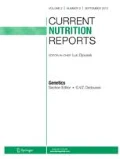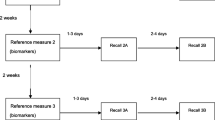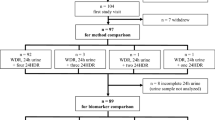Abstract
Purpose
Assessing food and nutrient intakes is critical to evolving our understanding of diet-disease relationships and the refinement of nutrition guidelines to support healthy populations. The aims of this narrative review are to summarise recent advances in dietary assessment methodologies, with a particular focus on approaches using new technologies, as well as strategies to evaluate tools, and to provide directions for future research.
Recent Findings
Technology as a mode to assess dietary intake has gained momentum in recent years, with the development of image-based methods and wearable devices, as well as the emergence of online methods of administering traditional paper-based approaches to dietary assessment. At the same time, there have been advances in the development of dietary biomarkers to evaluate measures of self-reported dietary intake. Common biomarkers, such as plasma carotenoids and red blood cell fatty acids, are still being utilised with new markers including urinary markers of sugar or wholegrain intake, skin carotenoids as a measure of fruit and vegetable intake. As well, the field of metabolomics shows promise.
Summary
Challenges remain in dietary intake assessment, and further efforts are required to refine and evaluate methods so that we can better understand diet-disease relationships and inform guidelines and interventions to promote health.
Similar content being viewed by others
References
Papers of particular interest, published recently, have been highlighted as: • Of importance •• Of major importance
Australian Institute of Health and Welfare. Risk factors contributing to chronic disease. In: Government A, editor.: AIHW; 2012.
Reedy J, Krebs-Smith SM, Miller PE, Liese AD, Kahle LL, Park Y, et al. Higher diet quality is associated with decreased risk of all-cause, cardiovascular disease, and cancer mortality among older adults. J Nutr. 2014;144(6):881–9.
Jacques PF, Tucker KL. Are dietary patterns useful for understanding the role of diet in chronic disease? Am J Clin Nutr. 2001;73(1):1–2.
Australian Government. Guideline development: Eat for Health; 2015. Available from: https://www.eatforhealth.gov.au/guidelines/guideline-development [cited 2016 June].
Risérus U, Willett WC, Hu FB. Dietary fats and prevention of type 2 diabetes. Prog Lipid Res. 2009;48(1):44–51.
Siri-Tarino PW, Sun Q, Hu FB, Krauss RM. Saturated fatty acids and risk of coronary heart disease: modulation by replacement nutrients. Current atherosclerosis reports. 2010;12(6):384–90.
de Souza RJ, Mente A, Maroleanu A, Cozma AI, Ha V, Kishibe T, et al. Intake of saturated and trans unsaturated fatty acids and risk of all cause mortality, cardiovascular disease, and type 2 diabetes: systematic review and meta-analysis of observational studies. 2015.
Astrup A, Dyerberg J, Elwood P, Hermansen K, Hu FB, Jakobsen MU, et al. The role of reducing intakes of saturated fat in the prevention of cardiovascular disease: where does the evidence stand in 2010? Am J Clin Nutr. 2011;93(4):684–8.
Malik VS, Popkin BM, Bray GA, Després J-P, Hu FB. Sugar-sweetened beverages, obesity, type 2 diabetes mellitus, and cardiovascular disease risk. Circulation. 2010;121(11):1356–64.
Medina-Remon A, Casas R, Tressserra-Rimbau A, Ros E, Martinez-Gonzalez MA, Fito M, et al. Polyphenol intake from a Mediterranean diet decreases inflammatory biomarkers related to atherosclerosis: a sub-study of The PREDIMED trial. Br J Clin Pharmacol. 2016.
European Commission. World food consumption patterns—trends and drivers. Europa; 2015.
Mueller S, Szolnoki G. The relative influence of packaging, labelling, branding and sensory attributes on liking and purchase intent: consumers differ in their responsiveness. Food Qual Prefer. 2010;21(7):774–83.
Gibson RS. Principles of nutritional assessment. USA: Oxford University Press; 2005.
National Institutes of Health. Dietary assessment primer: National Cancer Institute; 2014. Available from: http://dietassessmentprimer.cancer.gov [cited 2016 July].
• Hedrick VE, Dietrich AM, Estabrooks PA, Savla J, Serrano E, Davy BM. Dietary biomarkers: advances, limitations and future directions. Nutr J. 2012;11(1):1. This paper reviews existing literature on current biomarkers, including metabolomics, and discusses the limitations and future directions of the biomarker research.
Mishra G, McNaughton S, Bramwell G, Wadsworth M. Longitudinal changes in dietary patterns during adult life. Br J Nutr. 2006;96(04):735–44.
Popkin BM. Global nutrition dynamics: the world is shifting rapidly toward a diet linked with noncommunicable diseases. Am J Clin Nutr. 2006;84(2):289–98.
Archer E, Hand GA, Blair SN. Validity of US nutritional surveillance: national health and nutrition examination survey caloric energy intake data, 1971–2010. PloS one. 2013;8(10):e76632.
Archer E, Pavela G, Lavie CJ, editors. The inadmissibility of what we eat in America and NHANES dietary data in nutrition and obesity research and the scientific formulation of national dietary guidelines. Mayo Clin Proc. Elsevier; 2015.
Dhurandhar N, Schoeller D, Brown A, Heymsfield S, Thomas D, Sørensen T, et al. Energy balance measurement: when something is not better than nothing. Int J Obes (2005). 2015;39(7):1109–13.
Ioannidis JP. Implausible results in human nutrition research. BMJ. 2013;347:f6698.
Mitka M. Do flawed data on caloric intake from NHANES present problems for researchers and policy makers? JAMA. 2013;310(20):2137–8.
• Subar AF, Freedman LS, Tooze JA, Kirkpatrick SI, Boushey C, Neuhouser ML, et al. Addressing Current Criticism Regarding the Value of Self-Report Dietary Data. J Nutr. 2015. This commentary provides a balanced discussion on the strengths and limitations of self-report dietary intake data and delivers recommendations for collecting, analysing and interpreting dietary intake data.
Neuhouser ML, Tinker L, Shaw PA, Schoeller D, Bingham SA, Van Horn L, et al. Use of recovery biomarkers to calibrate nutrient consumption self-reports in the women’s health initiative. Am J Epidemiol. 2008;167(10):1247–59.
O’Sullivan A, Gibney MJ, Brennan L. Dietary intake patterns are reflected in metabolomic profiles: potential role in dietary assessment studies. Am J Clin Nutr. 2011;93(2):314–21.
Thompson FE, Subar AF, Loria CM, Reedy JL, Baranowski T. Need for technological innovation in dietary assessment. J Am Diet Assoc. 2010;110(1):48.
Beaton GH, Milner J, Corey P, McGuire V, Cousins M, Stewart E, et al. Sources of variance in 24-hour dietary recall data: implications for nutrition study design and interpretation. American J Clin Nutr (USA). 1979.
Freedman LS, Schatzkin A, Midthune D, Kipnis V. Dealing with dietary measurement error in nutritional cohort studies. J Natl Cancer Inst. 2011;103(14):1086–92.
Prentice RL, Huang Y. Measurement error modeling and nutritional epidemiology association analyses. Can J Stat. 2011;39(3):498–509.
Tooze JA, Kipnis V, Buckman DW, Carroll RJ, Freedman LS, Guenther PM, et al. A mixed effects model approach for estimating the distribution of usual intake of nutrients: the NCI method. Stat Med. 2010;29(27):2857–68.
Illner A, Freisling H, Boeing H, Huybrechts I, Crispim S, Slimani N. Review and evaluation of innovative technologies for measuring diet in nutritional epidemiology. Int J Epidemiol. 2012;41(4):1187–203.
•• Gemming L, Utter J, Ni MC. Image-assisted dietary assessment: a systematic review of the evidence. J Acad Nutr Diet. 2015;115(1):64–77. This is a comprehensive review that identifies studies using or evaluating validated image-assisted methods of dietary assessment. The review reports on the benefits of using image-assisted methods for reducing dietary misreporting.
Stumbo PJ. New technology in dietary assessment: a review of digital methods in improving food record accuracy. Proc Nutr Soc. 2013;72(01):70–6.
Innovation U. How mobile phones are changing the developing world UNICEF Connect2015. Available from: https://blogs.unicef.org/innovation/how-mobile-phones-are-changing-the-developing-world/ [cited 6 Aug 2016].
Burrows TL, Khambalia AZ, Perry R, Carty D, Hendrie GA, Allman‐Farinelli MA, et al. Great ‘app‐eal’but not there yet: a review of iPhone nutrition applications relevant to child weight management. Nutr Diet. 2015;72(4):363–7.
National Cancer Institute. Automated Self-Administered 24-Hour (ASA24®) Dietary Assessment Tool: NCI, Division of Cancer Control & Population Sciences; 2016. Available from: http://epi.grants.cancer.gov/asa24/ [cited 2016 August].
Burrows TL, Collins K, Watson J, Guest M, Boggess MM, Neve M, et al. Validity of the Australian recommended food score as a diet quality index for pre-schoolers. Nutr J. 2014;13:87.
Collins CE, Burrows TL, Rollo ME, Boggess MM, Watson JF, Guest M, et al. The comparative validity and reproducibility of a diet quality index for adults: the Australian recommended food score. Nutrients. 2015;7(2):785–98.
Khanna N, Boushey CJ, Kerr D, Okos M, Ebert DS, Delp EJ, editors. An overview of the technology assisted dietary assessment project at Purdue University. Multimedia (ISM), 2010 I.E. International Symposium on; 2010: IEEE.
Daugherty BL, Schap TE, Ettienne-Gittens R, Zhu FM, Bosch M, Delp EJ, et al. Novel technologies for assessing dietary intake: evaluating the usability of a mobile telephone food record among adults and adolescents. J Med Internet Res. 2012;14(2):e58.
Zhu F, Bosch M, Khanna N, Boushey CJ, Delp EJ. Multiple hypotheses image segmentation and classification with application to dietary assessment. IEEE J Biomed Health Inform. 2015;19(1):377–88.
Zhu F, Bosch M, Woo I, Kim S, Boushey CJ, Ebert DS, et al. The use of mobile devices in aiding dietary assessment and evaluation. IEEE J Sel Top Signal Process. 2010;4(4):756–66.
Harray AJ, Boushey CJ, Pollard CM, Delp EJ, Ahmad Z, Dhaliwal SS, et al. A novel dietary assessment method to measure a healthy and sustainable diet using the mobile food record: protocol and methodology. Nutrients. 2015;7(7):5375–95.
Kerr DA, Harray AJ, Pollard CM, Dhaliwal SS, Delp EJ, Howat PA, et al. The connecting health and technology study: a 6-month randomized controlled trial to improve nutrition behaviours using a mobile food record and text messaging support in young adults. Int J Behav Nutr Phys Act. 2016;13:52.
Rollo ME, Ash S, Lyons-Wall P, Russell AW. Evaluation of a mobile phone image-based dietary assessment method in adults with type 2 diabetes. Nutrients. 2015;7(6):4897–910.
Sun M, Burke LE, Mao ZH, Chen Y, Chen HC, Bai Y, et al. eButton: a wearable computer for health monitoring and personal assistance. Proc Des Autom Conf. 2014;2014:1–6.
Sun M, Fernstrom JD, Jia W, Hackworth SA, Yao N, Li Y, et al. A wearable electronic system for objective dietary assessment. J Am Diet Assoc. 2010;110(1):45.
Gemming L, Doherty A, Kelly P, Utter J, Ni MC. Feasibility of a SenseCam-assisted 24-h recall to reduce under-reporting of energy intake. Eur J Clin Nutr. 2013;67(10):1095–9.
Gemming L, Rush E, Maddison R, Doherty A, Gant N, Utter J, et al. Wearable cameras can reduce dietary under-reporting: doubly labelled water validation of a camera-assisted 24 h recall. Br J Nutr. 2015;113(2):284–91.
Kong F, He H, Raynor HA, Tan J. DietCam: multi-view regular shape food recognition with a camera phone. Pervasive and Mobile Computing. 2015;19:108–21.
Jia W, Chen H-C, Yue Y, Li Z, Fernstrom J, Bai Y, et al. Accuracy of food portion size estimation from digital pictures acquired by a chest-worn camera. Public Health Nutr. 2014;17(08):1671–81.
Martin CK, Nicklas T, Gunturk B, Correa JB, Allen HR, Champagne C. Measuring food intake with digital photography. J Hum Nutr Diet. 2014;27 Suppl 1:72–81.
Lunden I. 6.1B Smartphone Users Globally By 2020, Overtaking Basic Fixed Phone Subscriptions: Techcrunch; 2015. Available from: http://techcrunch.com/2015/06/02/6-1b-smartphone-users-globally-by-2020-overtaking-basic-fixed-phone-subscriptions/ [cited 4 May 2016].
Dong Y, Hoover A, Scisco J, Muth E. A new method for measuring meal intake in humans via automated wrist motion tracking. Appl Psychophysiol Biofeedback. 2012;37(3):205–15.
Salley JN, Hoover AW, Wilson ML, Muth ER. Comparison between human and bite-based methods of estimating caloric intake. J Acad Nutr Diet. 2016.
Farooq M, Fontana JM, Sazonov E. A novel approach for food intake detection using electroglottography. Physiol Meas. 2014;35(5):739–51.
Fontana JM, Higgins JA, Schuckers SC, Bellisle F, Pan Z, Melanson EL, et al. Energy intake estimation from counts of chews and swallows. Appetite. 2015;85:14–21.
Sazonov ES, Fontana JM. A sensor system for automatic detection of food intake through non-invasive monitoring of chewing. IEEE Sens J. 2012;12(5):1340–8.
Fontana JM, Farooq M, Sazonov E. Automatic ingestion monitor: a novel wearable device for monitoring of ingestive behavior. IEEE Trans Biomed Eng. 2014;61(6):1772–9.
Farooq M, Chandler-Laney PC, Hernandez-Reif M, Sazonov E. Monitoring of infant feeding behavior using a jaw motion sensor. J Healthcare Eng. 2015;6(1):23–40.
Farooq M, Sazonov E. A novel wearable device for food intake and physical activity recognition. Sensors (Basel, Switzerland). 2016;16(7):1067.
Jenab M, Slimani N, Bictash M, Ferrari P, Bingham SA. Biomarkers in nutritional epidemiology: applications, needs and new horizons. Hum Genet. 2009;125(5):507–25.
Corella D, Ordovás JM. Biomarkers: background, classification and guidelines for applications in nutritional epidemiology. Nutr Hosp. 2015;31(s03):177–88.
Burrows T, Truby H, Morgan P, Callister R, Davies P, Collins CE. A comparison and validation of child versus parent reporting of children’s energy intake using food frequency questionnaires versus food records: who’s an accurate reporter? Clin Nutr. 2013;32(4):613–8.
Puiggròs F, Solà R, Bladé C, Salvadó M-J, Arola L. Nutritional biomarkers and foodomic methodologies for qualitative and quantitative analysis of bioactive ingredients in dietary intervention studies. J Chromatogr A. 2011;1218(42):7399–414.
Collins CE, Burrows TL, Truby H, Morgan PJ, Wright IM, Davies PS, et al. Comparison of energy intake in toddlers assessed by food frequency questionnaire and total energy expenditure measured by the doubly labeled water method. J Acad Nutr Diet. 2013;113(3):459–63.
Burrows TL, Martin RJ, Collins CE. A systematic review of the validity of dietary assessment methods in children when compared with the method of doubly labeled water. J Am Diet Assoc. 2010;110(10):1501–10.
Freedman LS, Commins JM, Moler JE, Willett W, Tinker LF, Subar AF, et al. Pooled results from 5 validation studies of dietary self-report instruments using recovery biomarkers for potassium and sodium intake. Am J Epidemiol. 2015;181(7):473–87.
Bingham SA. Urine nitrogen as a biomarker for the validation of dietary protein intake. J Nutr. 2003;133(3):921S–4S.
Subar AF, Kipnis V, Troiano RP, Midthune D, Schoeller DA, Bingham S, et al. Using intake biomarkers to evaluate the extent of dietary misreporting in a large sample of adults: the OPEN study. Am J Epidemiol. 2003;158(1):1–13.
Burrows TL, Hutchesson MJ, Rollo ME, Boggess MM, Guest M, Collins CE. Fruit and vegetable intake assessed by food frequency questionnaire and plasma carotenoids: a validation study in adults. Nutrients. 2015;7(5):3240–51.
Burrows TL, Warren JM, Colyvas K, Garg ML, Collins CE. Validation of overweight children’s fruit and vegetable intake using plasma carotenoids. Obesity. 2009;17(1):162–8.
Burrows T, Berthon B, Garg ML, Collins CE. A comparative validation of a child food frequency questionnaire using red blood cell membrane fatty acids. Eur J Clin Nutr. 2012;66(7):825–9.
Yeung EH, Saudek CD, Jahren AH, Kao WHL, Islas M, Kraft R, et al. Evaluation of a novel isotope biomarker for dietary consumption of sweets. Am J Epidemiol. 2010:kwq247.
Davy BM, Jahren AH, Hedrick VE, Comber DL. Association of δ 13 C in fingerstick blood with added-sugar and sugar-sweetened beverage intake. J Am Diet Assoc. 2011;111(6):874–8.
Kuhnle GGC. Nutritional biomarkers for objective dietary assessment. J Sci Food Agric. 2012;92(6):1145–9.
Tasevska N. Urinary sugars—a biomarker of total sugars intake. Nutrients. 2015;7(7):5816–33.
O’Brien DM, Black JA, Niles K, Schoeller D. The breath carbon isotope ratio is a promising biomarker of added sugar intake. FASEB J. 2016;30(1 Supplement):43.5.
Choy K, Nash SH, Kristal AR, Hopkins S, Boyer BB, O’Brien DM. The carbon isotope ratio of alanine in red blood cells is a new candidate biomarker of sugar-sweetened beverage intake. J Nutr. 2013;143(6):878–84.
van Dam RM, Hu FB. Are alkylresorcinols accurate biomarkers for whole grain intake? Am J Clin Nutr. 2008;87(4):797–8.
Ermakov IV, Gellermann W. Optical detection methods for carotenoids in human skin. Arch Biochem Biophys. 2015;572:101–11.
Pezdirc K, Hutchesson MJ, Whitehead R, Ozakinci G, Perrett D, Collins CE. Fruit, vegetable and dietary carotenoid intakes explain variation in skin-color in young Caucasian women: a cross-sectional study. Nutrients. 2015;7(7):5800–15.
Gibbons H, Brennan L. Metabolomics as a tool in the identification of dietary biomarkers. Proc Nutr Soc. 2016; FirstView:1–12.
Hanhineva K, Lankinen MA, Pedret A, Schwab U, Kolehmainen M, Paananen J, et al. Nontargeted metabolite profiling discriminates diet-specific biomarkers for consumption of whole grains, fatty fish, and bilberries in a randomized controlled trial. J Nutr. 2015;145(1):7–17.
Brennan L. Metabolomics in nutrition research: current status and perspectives. Biochem Soc Trans. 2013;41(2):670–3.
Adeva MM, Calvino J, Souto G, Donapetry C. Insulin resistance and the metabolism of branched-chain amino acids in humans. Amino Acids. 2012;43(1):171–81.
• O’Gorman A, Brennan L. Metabolomic applications in nutritional research: a perspective. J Sci Food Agric. 2015;95(13):2567–70. This paper provides a summary of the application of metabolomics to the field of nutrition including biomarker identification, diet-related diseases and nutritional interventions.
Collins CE, Boggess MM, Watson JF, Guest M, Duncanson K, Pezdirc K, et al. Reproducibility and comparative validity of a food frequency questionnaire for Australian adults. Clin Nutr. 2014;33(5):906–14.
Freedman LS, Commins JM, Moler JE, Arab L, Baer DJ, Kipnis V, et al. Pooled results from 5 validation studies of dietary self-report instruments using recovery biomarkers for energy and protein intake. Am J Epi. 2014;80(2):172–188.
Lara JJ, Scott JA, Lean MEJ. Intentional mis-reporting of food consumption and its relationship with body mass index and psychological scores in women. J Human Nutr and Diet. 2004;17(3):209–218.
Lachat C, Hawwash D, Ocké MC, Berg C, Forsum E, Hörnell A, et al. Strengthening the reporting of observational studies in epidemiology - Nutritional Epidemiology (STROBE-nut): an extension of the STROBE statement. PLoS Med. 2016;13(6):e1002036.
Author information
Authors and Affiliations
Corresponding author
Ethics declarations
Conflict of Interest
Megan E. Rollo, Rebecca L. Williams, Tracy Burrows, Sharon I. Kirkpatrick, Tamara Bucher and Clare E. Collins declare that they have no conflict of interest.
Human and Animal Rights and Informed Consent
This article does not contain any studies with human or animal subjects performed by any of the authors.
Additional information
This article is part of the Topical Collection on Public Health and Translational Medicine
Rights and permissions
About this article
Cite this article
Rollo, M.E., Williams, R.L., Burrows, T. et al. What Are They Really Eating? A Review on New Approaches to Dietary Intake Assessment and Validation. Curr Nutr Rep 5, 307–314 (2016). https://doi.org/10.1007/s13668-016-0182-6
Published:
Issue Date:
DOI: https://doi.org/10.1007/s13668-016-0182-6




